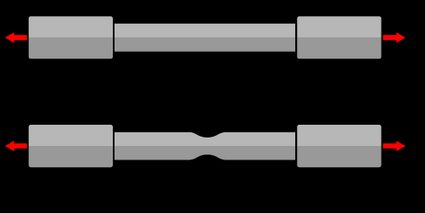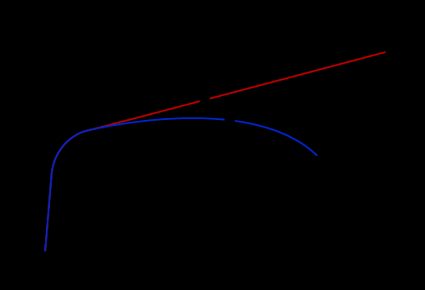True Strain Calculator
You can use the true strain calculator to convert the engineering stress-strain values into true strain values. Stresses play an essential role in the design of every component of machinery and equipment, be it a pen, airplane, or automobile engine. The birth of each machine or any component of it begins with the drawing board and analyses. The concept of stresses (see stress calculator) and strains form the basis of any design and analysis study.
So what is true stress? Read on to find out what engineering stress is and how do you convert it to true stress. If you wish to reinforce the concept of elongation (visit our elongation calculator).
True stress – Engineering stress
Consider a simple tensile test for a material specimen having a cross-sectional area, A (cf. cross sectional area calculator). When you exert pulling or tensile force on a material, the cross-sectional area decreases which leads to necking and ultimately failure. Now, the usual definition of stress, , is:
Here, the is the cross-sectional area of the specimen. However, it could either be an area of the undeformed specimen or a deformed one. While the equation to obtain stress remains, the type of stress calculation depends on the area used in the equation. If the stress is calculated based on the undeformed area, it is known as the nominal or engineering stress whereas when the reduced or instantaneous area is considered, the stress is known as the true stress.

For instance, the stress obtained using the above equation is the nominal or engineering stress. The equation gives the corresponding strain value:
where:
- – Deformed length of specimen; and
- – Undeformed length of specimen.
Add unity on both sides and take the natural log would give us the relationship between true strain, and nominal strain, :
Their stress counterparts — the nominal stress, and true stress, are related to each other using the equation below:
True stress curve vs nominal stress curve
Now that you know both types of stress, the question arises why do we need them, and where do we use them?
In simple terms, the engineering stress-strain data is based upon an unchanged reference, i.e., the undeformed cross-sectional area. In contrast, the true stress-strain data utilizes the dynamic change in the area to estimate the data. The true stress-strain data is important when studying the material behavior while considering strain hardening behavior, i.e., the stress-strain relationship beyond the yield point. True strain depicts the actual strain on the specimens.
Most CAE tools like ABAQUS and ANSYS accept true stress-strain data to compute the plastic behavior of the material. Therefore, you'll have to convert the engineering or nominal stress-strain curve into a true one before inputting the data into the software. The figure below depicts the difference between the true and engineering stress-strain. You can notice that, unlike the engineering stress curve, the true stress curve goes on increasing.

Example: Using the true strain calculator
Find the true stress for nominal stress of 8 MPa. Take nominal strain as 0.1.
To find the true stress value:
- Enter the engineering strain as
0.1. - The true strain calculator will return
0.09531as the value of the true strain. - Fill in the engineering or nominal stress as
8 MPa. - Using the true stress calculator:
FAQs
What is the difference between true stress and engineering stress?
The difference between true stress and engineering stress is that the engineering stress is based on an unchanged reference, i.e., the undeformed crossectional area, whereas for the calculation of true stress, the instantaneous cross-sectional area is considered. True stress is beneficial to model strain hardening behavior.
How do I calculate true strain from engineering strain?
To calculate true strain:
- Find the nominal or engineering strain value.
- Add
1to the engineering strain value. - Find the natural logarithm of the sum to obtain the corresponding true strain value. Mathematically,
Ɛ = ln(1 + Ɛ_nom).
How do I calculate true stress from engineering stress?
To calculate true stress:
- Find the nominal or engineering strain value.
- Add
1to the engineering strain value. - Multiply the sum by the engineering stress value to obtain the corresponding true stress value. Mathematically,
σ = σ_nom(1 + Ɛ_nom).
How do I convert the engineering strain 0.05 to true strain?
The true strain counterpart for an engineering strain of 0.05 is 0.04879. Mathematically, the true strain, Ɛ = ln (1 + Ɛ_nom) = ln(1 + 0.05) = 0.04879. Here, Ɛ_nom is the nominal or engineering strain. You can also use the value of nominal strain to find the true stress if you know the corresponding nominal strain value.